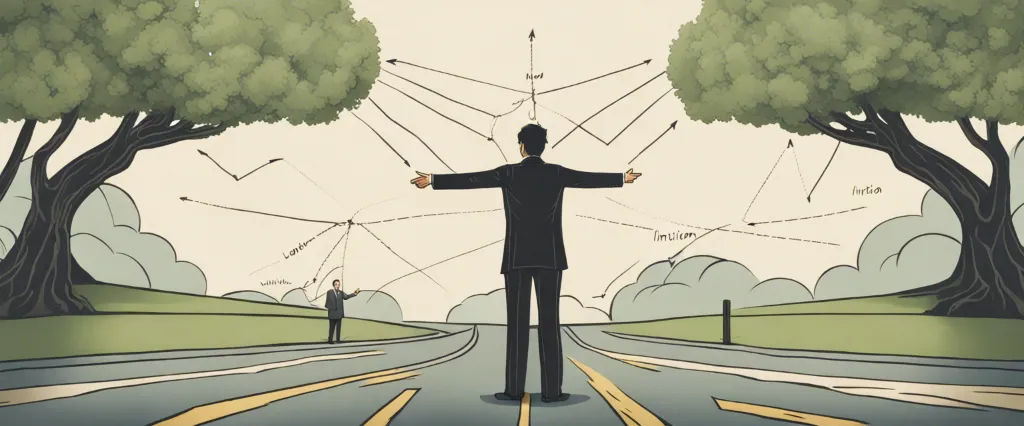
In “A Guide to the Good Life: The Ancient Art of Stoic Joy” by William B. Irvine, the author takes us on a compelling journey exploring the philosophy of Stoicism and its applicability in modern life. With a desire to find lasting happiness and inner tranquility, Irvine delves into the ancient wisdom of Stoic philosophers to present practical techniques for achieving joy and contentment. As a renowned philosopher, William B. Irvine combines his passion for Stoicism with his experience as a professor of philosophy, providing readers with profound insights and actionable advice on how to lead a fulfilling life.
Chapter 1: The Philosophy of Stoicism
In Chapter 1 of “A Guide to the Good Life” by William B. Irvine, the author introduces the philosophy of Stoicism as a guide to achieving a good life and finding happiness. Irvine explains that Stoicism originated in ancient Greece and became particularly popular in ancient Rome, offering a practical philosophy to help individuals navigate the inevitability of suffering and find tranquility in life.
Stoicism suggests that the key to a good life lies in developing an attitude of indifference towards things beyond our control, focusing instead on cultivating virtues within ourselves. Irvine argues that while we may not have control over external circumstances or the actions of others, we can control our own thoughts, emotions, and responses. By doing so, we can achieve a sense of inner peace and live in harmony with the world.
The Stoics emphasize the importance of distinguishing between what is within our control and what is not. They advocate for the acceptance of the natural order of the universe and encourage individuals to adapt their desires and expectations accordingly. According to Stoic philosophy, the desire for external things beyond our control often leads to dissatisfaction, whereas focusing on internal virtues, such as wisdom, courage, and self-discipline, provides a more reliable source of happiness.
Irvine also highlights the Stoic belief in the impermanence of external possessions. By recognizing the transient nature of material things, Stoics find contentment in living modestly and minimizing attachments to material possessions. This perspective allows individuals to detach their happiness from external circumstances and focus instead on cultivating virtues and maintaining a sense of personal fulfillment.
In summary, Chapter 1 introduces Stoicism as a philosophy that teaches individuals to overcome suffering and find tranquility by abandoning desires for external things beyond their control. By directing their focus towards internal virtues and accepting the natural order of the universe, Stoics aim to achieve a good life characterized by inner peace and personal fulfillment.
Chapter 2: The Dichotomy of Control
Chapter 2 of “A Guide to the Good Life” by William B. Irvine focuses on the Stoic concept of the “dichotomy of control.” This refers to the divide between things we have control over and those we do not. The Stoics argue that by recognizing and accepting this dichotomy, we can achieve a more content and virtuous life.
Irvine begins by explaining that the Stoics believed that the only things truly under our control are our thoughts and actions. All external events and circumstances, such as the actions of others, the passage of time, and even our physical bodies, are beyond our control. Therefore, putting too much emphasis on these external factors leads to suffering and anxiety.
The author highlights three key Stoic principles that accompany this understanding. First, we should focus on our goals and desires that are within our control, rather than becoming fixated on outcomes that are not. Second, we should cultivate a mindset of indifference towards external events, reminding ourselves that they are beyond our control. And finally, we should be vigilant in differentiating between what we can control and what we cannot, as this clarity will help us avoid wasting time and energy on the latter.
Irvine goes on to explore various examples and practical techniques for applying the dichotomy of control in our daily lives. For instance, he suggests mentally rehearsing worst-case scenarios in order to prepare ourselves for adverse events. By doing so, we become less attached to specific outcomes and more adaptable in the face of adversity.
Ultimately, understanding and embracing the dichotomy of control enables us to live a more tranquil and fulfilled existence. By focusing on what is within our power and accepting what is not, we can navigate life’s challenges with resilience and wisdom.
Chapter 3: Desire and Aversion
Chapter 3 of “A Guide to the Good Life” by William B. Irvine discusses the Stoic philosophy’s approach to desire and aversion. The chapter explores how cultivating a healthy relationship with desire can lead to a more fulfilled and content life.
Irvine begins by addressing how desire often dictates our lives, causing us to constantly seek external objects that we believe will bring us happiness and fulfillment. However, the Stoics argue that relying on external circumstances for our contentment is risky, as these circumstances are often beyond our control. Instead, they encourage individuals to turn inward and focus on internalizing their desires.
The Stoics propose a shift in desire from external objects towards internal virtues. They argue that focusing on virtues such as wisdom, courage, justice, and temperance leads to a more stable and lasting form of happiness. By cultivating these virtues, individuals can find fulfillment within themselves, regardless of their external circumstances.
Additionally, the Stoics emphasize the importance of distinguishing between desires and preferences. They suggest that we can have preferences, but should not be attached to them. Preferences are not absolute necessities, and if they are not met, we should not allow them to disturb our inner peace. This detachment allows us to remain content and resilient in the face of adversity.
Furthermore, the Stoics propose the practice of negative visualization, which involves contemplating the loss of the things we value. By envisioning the absence of these desires, we gain perspective and become more appreciative of what we have. This exercise also helps one prepare for future adversities, reducing the impact of loss and disappointment.
Overall, Chapter 3 teaches us to reassess our desires, shift our focus to virtues, detach from preferences, and engage in negative visualization. By adopting these Stoic principles, we can develop a mindset that is more resilient, content, and ultimately leads to a good life.
Chapter 4: Negative Visualization

Chapter 4 of “A Guide to the Good Life” by William B. Irvine explores the philosophical technique known as negative visualization, which involves visualizing potential negative scenarios or losses as a means of cultivating gratitude and mental resilience.
Irvine emphasizes the mindset of “premeditation of evils,” an ancient Stoic exercise where individuals contemplate the loss or absence of the things they value, whether possessions, relationships, or even life itself. The purpose of negative visualization is not to induce fear or sadness but rather to enhance one’s appreciation for what they have in the present moment.
The Stoics believed that human desires often surpass what they possess, leading to dissatisfaction and a perpetual quest for more. Negative visualization serves as an antidote to this insatiable desire by reminding individuals of the transitory nature of everything and fostering a sense of contentment with what they already possess. By imagining the loss of a particular possession or a loved one, individuals begin to recognize that these things are not guaranteed and should be cherished while they are available.
Through negative visualization, individuals strive to become mentally prepared for potential losses, enabling them to face adversity with equanimity. Irvine suggests practicing negative visualization regularly, starting with minor inconveniences and gradually moving towards more significant challenges. By engaging in this exercise, individuals become less reliant on external circumstances for their well-being and develop a greater sense of control over their own happiness.
Overall, Chapter 4 of “A Guide to the Good Life” encourages readers to adopt negative visualization as a practical Stoic technique for cultivating gratitude, reducing desire, and building emotional resilience.
Chapter 5: Stoic Mindfulness and Acceptance
Chapter 5 of “A Guide to the Good Life” by William B. Irvine explores the concepts of Stoic mindfulness and acceptance as key components of living a fulfilled and virtuous life. The chapter begins by acknowledging the difficulty of achieving lasting happiness in a world full of external events and circumstances beyond our control. Stoicism teaches us to focus on what is within our control, namely our attitudes, opinions, and actions.
Irvine introduces mindfulness as the practice of being fully present in the present moment and observing our thoughts and emotions without judgment. By developing this introspective awareness, we gain the ability to recognize and challenge unhealthy thoughts and replace them with more rational and virtuous ones. This helps us to reduce our negative emotions such as anger, envy, and anxiety, and cultivate a sense of tranquility and inner peace.
Acceptance, the next concept explored, involves recognizing and embracing the reality of our situation, even if it’s undesirable or challenging. Stoicism teaches us to differentiate between what is up to us and what lies beyond our control. By accepting that certain events are outside our sphere of influence, we can redirect our focus towards what we can control: our reactions and our choices. This mindset shift enables us to approach life’s hardships with resilience and equanimity.
Irvine illustrates the Stoic practice of acceptance by using the example of a Stoic philosopher being exiled from his home. Instead of lamenting his situation, the philosopher accepts his fate and uses the opportunity to strengthen his philosophical character and continue pursuing a virtuous life. Stoicism teaches that embracing and adapting to adversity allows us to grow wiser and more resilient.
In summary, Chapter 5 presents mindfulness and acceptance as essential tools for leading a meaningful life. By practicing these Stoic principles, we can cultivate tranquility, reduce negative emotions, and face life’s challenges with resilience and wisdom.
Chapter 6: Stoic Ethics and Virtue
Chapter 6 of “A Guide to the Good Life” by William B. Irvine delves into Stoic ethics and the concept of virtue. The Stoics believed that the key to achieving a good life lies in living virtuously, and they defined virtue as knowledge of what is good and evil. They also held the belief that virtue is the only true good and that external possessions and pleasures are indifferent and not necessary for a flourishing life.
The chapter begins by examining the four cardinal virtues identified by the Stoics: wisdom, courage, justice, and temperance. These virtues are seen as interconnected and essential for achieving a fulfilled life. Irvine highlights how each virtue can be developed and practiced by individuals to cultivate a virtuous character.
The author also explores the Stoic concept of preferred indifferents – things such as health, wealth, and reputation, which are preferred but ultimately not essential for happiness. Stoics stress the importance of not becoming overly attached to these things, as they are often outside of our control and can lead to suffering if we depend on them for our well-being.
Additionally, the chapter explores the Stoic view on moral responsibility. Stoics believe that individuals are responsible for their actions and attitudes but not for external outcomes. Thus, they emphasize focusing on one’s own choices and intentions rather than attempting to control external events or the actions of others.
Overall, Chapter 6 provides a comprehensive overview of Stoic ethics and the importance of cultivating virtue as the guiding principle for a good life. It presents the Stoic viewpoint on virtue, preferred indifferents, and moral responsibility, highlighting how these concepts can be applied to improve one’s well-being and maintain a sense of inner tranquility.
Chapter 7: Stoic Resilience and Adversity
Chapter 7: Stoic Resilience and Adversity of the book A Guide to the Good Life by William B. Irvine discusses the Stoic philosophy’s approach to building resilience and facing adversity. The chapter explores various techniques and practices designed to help individuals develop inner strength and withstand challenging circumstances.
Irvine begins by explaining the Stoic concept of indifferents, which are external events or circumstances beyond our control, such as illness, loss, or rejection. Stoics believe that true happiness lies in focusing solely on what can be controlled: our own thoughts, attitudes, and actions. By recognizing that indifferents should not define our well-being, Stoics aim to cultivate resilience in the face of adversity.
One technique discussed in the chapter is negative visualization, a practice of considering worst-case scenarios to prepare oneself mentally. Stoics argue that by envisioning and accepting potential hardships, individuals can develop a greater appreciation for what they have and build resilience to withstand future challenges.
Additionally, the Stoic philosophy emphasizes the significance of self-denial and voluntary discomfort. By deliberately depriving oneself of certain pleasures or enduring discomfort, Stoics believe one can build resilience and strengthen their character. This self-imposed hardship allows individuals to gain a sense of control over their desires and foster mental toughness.
The chapter also explores the Stoic concept of dichotomy of control, which emphasizes the importance of distinguishing between external events and our internal responses. Stoics encourage individuals to focus on their own thoughts and reactions rather than being overwhelmed by external circumstances. This mental framing helps to reduce suffering and build resilience.
In summary, Chapter 7 of A Guide to the Good Life delves into the Stoic philosophy’s approach to resilience and facing adversity. Through practices such as negative visualization, self-denial, and focusing on what can be controlled, Stoics aim to strengthen their character, foster mental toughness, and find lasting happiness despite challenging circumstances.

Chapter 8: Applying Stoicism in Daily Life
In Chapter 8 of “A Guide to the Good Life” by William B. Irvine, the author explores the practical application of Stoicism in daily life. Stoicism is an ancient philosophy that teaches individuals to cultivate virtue and live in harmony with nature. It emphasizes the importance of focusing on what is within our control and accepting what is not.
To begin with, Irvine suggests that practicing negative visualization can help individuals appreciate the things they have by imagining their loss. By visualizing the absence of certain pleasures or loved ones, we can become more grateful and less attached, reducing the potential for disappointment.
Next, the author discusses the importance of self-denial and voluntary discomfort. By occasionally subjecting ourselves to discomfort, such as fasting or cold showers, we can strengthen our resilience and learn to be content with less. It also prepares us for potential hardships that life may throw at us.
Embracing the philosophy of Stoicism also involves being mindful of our judgments and reactions towards events. We should strive to develop an objective and rational mindset, void of emotional extremes. This enables us to maintain equanimity in the face of challenging circumstances and not be easily swayed by external factors.
Furthermore, Irvine highlights the value of taking regular breaks from the pursuit of pleasure and indulgence. By abstaining from certain pleasures for a period of time, we can regain control over our desires and reduce their sway over us. This self-imposed moderation allows us to appreciate the simple joys of life and avoid excess.
In conclusion, applying Stoicism in daily life involves practicing negative visualization, self-denial, mindfulness, and moderation. By implementing these techniques, individuals can cultivate greater gratitude, resilience, tranquility, and a life more aligned with nature and virtue.
After Reading
In “A Guide to the Good Life” by William B. Irvine, the author explores the teachings of the ancient philosophy of Stoicism and its relevance to modern-day life. Irvine introduces readers to the core principles of Stoicism, emphasizing the importance of cultivating inner tranquility and finding contentment in the face of external circumstances. He provides practical techniques and exercises to help individuals apply Stoic principles to their daily lives, such as practicing negative visualization, defining what is within our control, and embracing adversity as a means of personal growth. Through insightful anecdotes and compelling arguments, Irvine concludes that by adopting Stoic practices, individuals can achieve lasting happiness and a sense of purpose, regardless of the challenges they may encounter. With its practical approach and timeless wisdom, “A Guide to the Good Life” serves as an accessible and valuable resource for anyone seeking to live a more fulfilling and meaningful existence.
1. Man’s Search for Meaning” by Viktor E. Frankl: This profound book explores the author’s experiences as a Holocaust survivor and psychiatrist, and how finding meaning in life can help overcome even the most challenging circumstances.
2. The Power of Now” by Eckhart Tolle: In this spiritual guide, Tolle emphasizes living in the present moment and cultivating awareness, offering practical insights to help readers break free from the constraints of their mind and find peace.
3. Sapiens: A Brief History of Humankind” by Yuval Noah Harari: This captivating book takes readers on a fascinating journey through the history of Homo sapiens, exploring our cognitive and social development, and challenging conventional notions about our species’ impact on the world.
4. Quiet: The Power of Introverts in a World That Can’t Stop Talking” by Susan Cain: For those who identify as introverts or simply wish to better understand them, Cain’s insightful book delves into the strengths and unique qualities introverts bring to society, shedding light on a widely misunderstood personality trait.
5. Blink: The Power of Thinking Without Thinking” by Malcolm Gladwell: In his characteristic thought-provoking style, Gladwell examines the power of intuition, exploring how snap judgments can be more effective than considered decisions. This book challenges our understanding of decision-making processes and offers useful insights for daily life.



